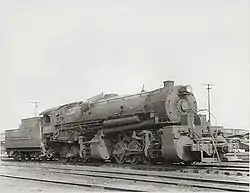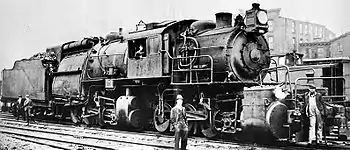0-8-8-0
In the Whyte notation for classifying the wheel arrangement of steam locomotives, an 0-8-8-0 is a locomotive with two sets of eight driving wheels and neither leading wheels nor trailing wheels. Two sets of driving wheels would give far too long a wheelbase to be mounted in a fixed locomotive frame, so all 0-8-8-0s have been articulated locomotives of the Mallet type, whether simple or compound. In the UIC classification, this arrangement would be, refined to Mallet locomotives, (D)D. The type was sometimes called Angus in North America.[1]

Other equivalent classifications are:
UIC classification: DD (also known as German classification and Italian classification)
French classification: 040+040
Turkish classification: 44+44
Swiss classification: 4/4+4/4
The lack of leading and trailing wheels to assist the tracking and stability of the locomotive means that the 0-8-8-0 type is not suited to high speeds. The vast majority have seen use as very heavy switchers (generally for hump yard work), transfer locomotives for hauling cuts of cars between rail yards, or pushers for assistance on grades.
Most locomotives of this arrangement were built and served in North America, but there were exceptions. The Bavarian State Railways (K.Bay.St.B) built some 0-8-8-0T tank locomotives of class Gt 2x4/4, classified after unification of Germany's railway systems as class BR96. These worked trains over heavily graded stretches of line, and were the largest locomotives in Europe when introduced.
Failures
In 1915, the New York Central purchased an 0-8-8-0 numbered 2000 but proved to be very unreliable and also very costly to maintain as the engine steamed poorly and jumped the rails often. The mallet was then only restricted to working in the yards in Albany, New York marshaling freight trains for the L1 and L2 class Mohawks. These mohawks would carry freight west towards Utica or south towards Poughkeepsie. Eventually in the 1930s, the engine was split into two locomotives. The result was a useful 2-8-0 freight engine and a barely functional 0-8-0T switcher engine. The switcher engine was later sold to the N&W where they decided to convert their W2 2-8-0's to the newly designated W6 class 0-8-0t's based on the aftermath of the NYC 0-8-8-0 that earlier was cut into two engines because at the time they were looking for a yard goat engine that could work in the yards of Roanoke. This would keep the N&W W6 class engines busy working near and around the area of Roanoke like bringing engines in for servicing, taking the engines to the coal elevators, water towers, the ready tracks and so on while the successful N&W S1 and S1a's would handle the major switching tasks and servicing the local industries nearby. The original 0-8-0 was sold for scrap by 1950 while the W6 copies lasted until their retirement after 1958. The 2-8-0 freight engine maintained into service until NYC dieselization during the mid 1950s. The 2-8-0 and 0-8-0 locomotives that were from the 0-8-8-0 locomotive chassis do not exist anymore.
Popular culture
Used in Lionel O gauge only in Erie and Pennsylvania road names
References
- Boylan, Richard; Barris, Wes (1991-05-30). "American Steam Locomotive Wheel Arrangements". SteamLocomotive.com. Archived from the original on 26 January 2008. Retrieved 2008-02-08.

